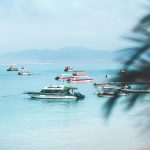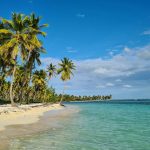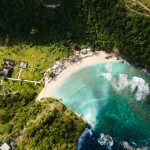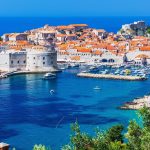Table of Contents
While tourists flock to Copacabana and Ipanema, Brazil’s most breathtaking beaches remain blissfully uncrowded. Beyond Rio and São Paulo lies 4,650 miles of coastline hiding pristine islands, untouched fishing villages, and strips of sand that redefine what a perfect beach can be. Here’s your guide to the beaches of Brazil and its true coastal treasures.
Fernando de Noronha: The Protected Paradise
Fernando de Noronha isn’t exactly unknown, but its strict visitor limitations preserve its extraordinary nature. This volcanic archipelago 220 miles off Brazil’s northeast coast limits daily visitors to 500, ensuring places like Baía do Sancho – consistently ranked among the world’s top beaches – remain pristine.
What sets Noronha apart isn’t just the crystalline waters but the wildlife encounters. Spinner dolphins perform acrobatic displays in Dolphins Bay each morning. Sea turtles nest on protected beaches, and reef sharks cruise the shallows at Sueste Bay. The island enforces strict environmental regulations, including an environmental preservation tax that increases with each day of your stay, effectively encouraging shorter visits.
The best strategy? Visit during shoulder season (April or November) when rains are infrequent but tourists are fewer. Stay in pousadas in the Vila dos Remédios rather than luxury accommodations to extend your budget, and focus on the island’s natural attractions rather than its limited nightlife.
Jericoacoara: From Fishing Village to Paradise
Once a remote fishing village accessible only by 4×4 across shifting dunes, “Jeri” has developed into a windsurfing mecca while maintaining its bohemian character. Located in Ceará state, its strict building codes prohibit street lights and paved roads, keeping environmental impact minimal and ensuring stargazing remains spectacular.
The beach itself features unusual rock formations, tranquil tide pools, and the famous Duna do Pôr do Sol (Sunset Dune) where crowds gather for evening views. But the true magic happens on excursions to surrounding attractions like the Lagoa Azul and Lagoa Paraíso – freshwater lagoons where the watercolor shifts between turquoise and emerald depending on the sunlight.
Visit between August and December for ideal conditions – strong enough winds for kitesurfing but before the rainy season begins. Accommodation ranges from simple pousadas to upscale boutique hotels, but all maintain the village’s unpretentious atmosphere.
Ilha Grande: Atlantic Rainforest Meets Perfect Beaches
Just a few hours from Rio lies Ilha Grande, where primitive Atlantic rainforest cascades down to pristine beaches. The island’s development remains limited due to its history – it housed a high-security prison until 1994, effectively preserving the environment while the rest of Brazil’s coast urbanized.
Lopes Mendes Beach stretches for nearly two miles of powder-white sand and crystal-clear water, accessible only via a 30-minute hike through the jungle from the nearest boat landing. The trek filters out casual tourists, ensuring you’ll find space even during peak season.
The island’s main settlement, Vila do Abraão, offers basic infrastructure without overwhelming the natural setting. No cars are allowed, and nightlife centers around low-key beachfront bars rather than clubs. Hiking trails crisscross the island, leading to hidden beaches like Praia do Pouso and Dois Rios where the abandoned prison stands.
Trancoso: Bohemian Luxury on Bahia’s Discovery Coast
In southern Bahia, Trancoso has evolved from a hippie hideaway to a sophisticated retreat without losing its essential character. The village centers around the Quadrado, a grassy rectangle lined with colorful 16th-century fishermen’s cottages now housing boutiques and restaurants. Steps from this historic center, the beach stretches for miles in both directions.
What distinguishes Trancoso is the dramatic setting – beaches sit below towering cliffs topped with native Atlantic Forest. The most spectacular stretch, Praia dos Nativos, features natural pools formed during low tide and rustic restaurants where tables sit directly on the sand.
The region maintains its authentic Bahian culture despite development, with local fishermen still launching traditional boats each morning. Visit between March and May after the Brazilian holiday season ends but before winter rains begin. Accommodations range from simple pousadas to ultra-luxury properties hidden in the surrounding forest.
Alter do Chão: The Amazon’s Beach Secret
Few travelers realize the Amazon offers world-class beaches. During the dry season (August to December), the receding Amazon tributaries reveal white-sand beaches that rival any coastal destination. Alter do Chão, located on the Tapajós River in Pará state, centers around the Ilha do Amor (Love Island), a sandbar peninsula with beaches on both sides.
The emerald water comes from the Tapajós, one of the Amazon’s clearest tributaries, creating the surreal experience of tropical beaches surrounded by rainforest. Local boats shuttle visitors to nearby beaches like Ponta de Pedras or into flooded forest areas where you might spot pink river dolphins.
The village itself maintains its Amazonian character, with simple restaurants serving regional specialties like tucunaré (peacock bass) and tacacá (a traditional soup). Visit in November for ideal conditions – warm weather, minimal rain, and maximum exposed beach area as river levels reach their lowest point.
Pipa: Dolphins, Cliffs, and Sophisticated Beach Life
In Rio Grande do Norte state, Pipa transformed from a surfer outpost to one of Brazil’s most appealing beach towns. The main beach, backed by dramatic red cliffs, offers reliable dolphin sightings – resident pods of spinner dolphins cruise the bay throughout the year, often swimming within meters of beachgoers.
Pipa balances natural beauty with sophisticated infrastructure. The town center features cobblestone streets lined with restaurants serving international cuisine alongside traditional northeastern specialties. Beaches like Praia do Madeiro and Baía dos Golfinhos provide different atmospheres, from surfer-friendly waves to protected natural pools.
The region maintains large stretches of environmental preservation areas, including the Santuário Ecológico de Pipa, ensuring development remains controlled. Visit between April and July when northeastern Brazil enjoys consistent sunshine without the intense heat of summer.
Boipeba: Bahia’s Untouched Island
While nearby Morro de São Paulo draws crowds, Boipeba remains delightfully undeveloped. Located in Bahia’s Tinharé archipelago, the island combines pristine beaches with mangrove forests and traditional communities where tourism hasn’t displaced traditional fishing livelihoods.
Praia de Cueira and Praia de Bainema stretch for miles without development beyond occasional rustic beach bars serving fresh seafood and cold drinks. The absence of cars and limited electricity (many areas use generators only during evening hours) maintains the island’s tranquil atmosphere.
The main village, Velha Boipeba, consists of sandy streets lined with simple pousadas and restaurants. Access requires effort – typically a combination of ferry, motorboat, and tractor ride – effectively filtering out mass tourism. Visit between January and March for perfect weather, though the island remains appealing year-round.
The Future of Brazilian Beach Travel
Brazil’s coastal tourism continues evolving, with an increasing focus on sustainability and environmental preservation. Emerging destinations like Maraú Peninsula in southern Bahia and Carneiros Beach in Pernambuco demonstrate how thoughtful development can maintain natural character while improving accessibility.
The most rewarding Brazilian beach experiences combine natural beauty with cultural immersion – eating freshly caught seafood prepared with regional techniques, hearing local music traditions, and understanding the distinct character each coastal region has developed.

I’m Garrett, a seasoned photojournalist with a passion for uncovering the world’s hidden treasures. My journey is fueled by a deep curiosity for diverse cultures and breathtaking landscapes. When I’m not behind the lens capturing the world’s wonders, you can find me exploring underwater realms or sharing my passion for discovery with my two adventurous children.




